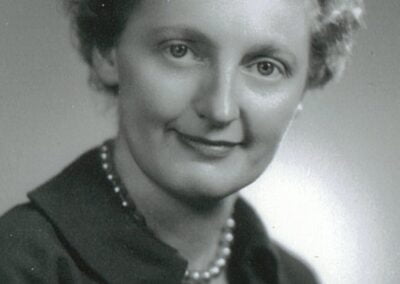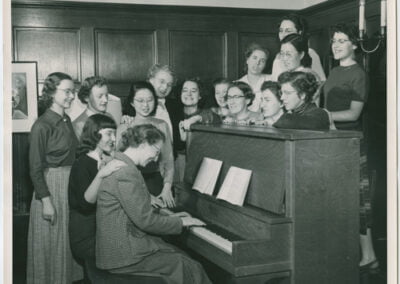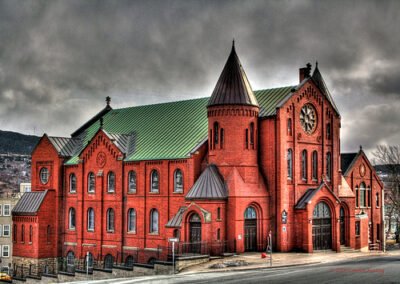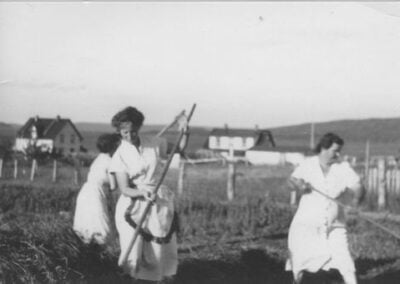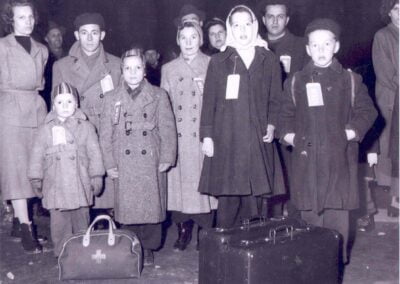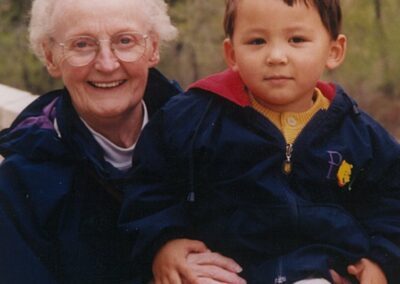In Memorium
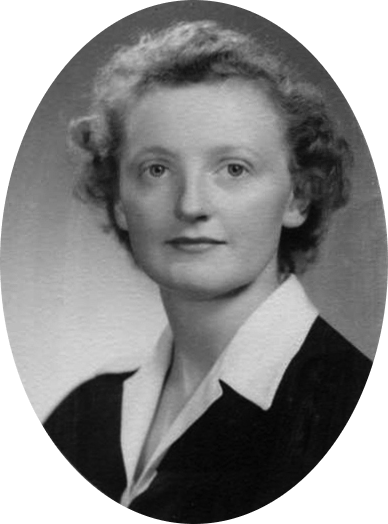
Etta-Snow-at-piano-with-UCTS-Students-in-1950
Etta Snow at piano with UCTS Students, including Frances, in 1950
Frances Steele was by nature a humble woman. She didn’t like to draw attention to her own accomplishments; rather, she took pleasure in letting the sun shine on others. She was wonderfully creative, hard-working and energetic. Frances could have high expectations of herself, and of others. She was willing though to team with people to provide the support for them to meet those expectations, especially for the glory of God.
In the 1990s Frances began to exhibit the signs of forgetfulness that would be diagnosed as Alzheimers. James, her husband, expressed some regret that he didn’t learn more about her ministry when she could remember the details. Fortunately, a small trail of documents give insight into this wonderful woman. Even though Frances was only officially a Deaconess for eight years, she left a strong legacy and did the Deaconess movement proud.
Frances was born June 16, 1925, just a month after the formation of the United Church, on the family farm in Mapleton, Nova Scotia, the daughter of Knox and Elizabeth Lodge. She grew up in Amherst, Nova Scotia, where her father held several jobs; farm hand, lumberman and later a tanner. The family roots were Methodist, and Frances was active in the United Church.
At the age of 20, in September, 1945, Frances traveled to Boston, Massachusetts to attend Gordon College of Theology and Mission, graduating in 1949 with a Bachelor’s degree in Theology. Her mother, Elizabeth, and sister, Olive, traveled to Boston to be present at the graduation. Frances made the Dean’s list every semester and was Valedictorian of her graduating class. She and her friend Rena Fraser, were “elected to membership” in the honorary society of Phi Alpha Chi. Membership was only open to students maintaining an average above 90% and displayed Christian character, creative ability and promise of achievement in Christian service. In a letter from her mother expressing her pride, she cautions her to keep a level head, “as you will be getting tired of all the praise.” But Frances never let her gifts manifest in arrogance; she was generous in passing on the things God had bestowed her with.
Obviously a keen learner, in 1950, Frances traveled to Toronto for further education in the program of study to become a Deaconess at the United Church Training School. It was a heady time at the Training School. The post war boom, with churches sprouting up all over the country, and the rising demand for Christian Education workers resulted in the largest student enrollment for the school to date. Frances attended the school for two years, even though she had a prior degree. A one year program was all that was required for students with an undergraduate degree, although some women elected to attend for two years to get the additional training. Frances graduated in 1952, a member of the largest graduating class the school had ever experienced. Frances was again the Valedictorian for the graduating class. An impressive honour, given the size of the class, and the calibre of her classmates!
This period of Frances’ life gave her great satisfaction and she remembered her school years with fondness. Toward the end of her life when she entered a nursing home she thought she had returned to the school residence, asking her daughter, “how are your classes . . . I am loving mine . . . I am so happy to be here!”
Frances accepted a position at Gower Street United Church in St. John’s, Newfoundland, to work under the minister, Rev. Francis E. Vipond, with responsibilities for Christian Education in the large congregation. As was the custom at the time, she served her first year in a sort of probationary status as a Deaconess Candidate. In June 1953 she was designated a Deaconess by Newfoundland Conference.
Gower Street had a long tradition of Deaconesses, but it had been nearly 20 years since May Field had occupied the position. The baby boom and its resulting effect on the church school population could have been a motivation for the congregation to seek professional support. So too might have been the resignation two years before of William Peters, who for 50 years had been the Superintendent of Sunday School![i]
This entry was in the Gower bulletin on June 29, 1952: “Miss Frances Lodge, of Amherst, Nova Scotia, who as Deaconess is coming to help us in the work of the Church, will take up her duties some time during the first half of the month of August.” And then from the bulletin of September 7, 1952: “Miss Lodge will be in her office in the Church (Classroom 2), emergencies excepted, from 10:30 to 12:30 each morning except Wednesday so that she may be available to members of the congregation for the various ministries which she may render.”[ii]
The detail on what exactly Frances did is not clear, although just supporting the Sunday school program would have been a large responsibility. The 1956 Baby Band (for children ages 2 and 3) had at least 45 members![iii] She did begin an Explorer’s group and was heavily involved in Canadian Girls in Training (CGIT), both within the congregation and beyond. In a 1955 report for the Woman’s Missionary Society, Deaconess Stella Burry, a community worker for St. John’s, noted Frances’ leadership at the 1954 summer CGIT camp. Stella, having been ordered to take an extended holiday for rest and renewal earlier that spring, which she did in Florida, was particularly thankful that Frances provided such capable and reliable leadership. [iv]
It is also likely that Frances was involved in 1953 with the “Youth for Christ” mission conducted by evangelist Charles Templeton in which over 200 “pledged their lives in service to Christ”.[v] Gower Street’s youth ministry was extensive, as Lorraine (Roberts) Mountford, a member of the congregation in this period recalls. “I grew up at [Gower Street United] Church. I did everything possible, from Mission Band, CGIT, everything as a girl and when I got older I was the leader, I’ve been doing church work all my life really.” Frances had a life time influence on Lorraine, mentoring her when she was offering leadership as a young adult. “We were quite close, we worked together and she taught me a lot about what church work was about.” Frances, along with another Deaconess, Ruth Tillman, were the models for Loraine when she became a Deaconess in 1959.[vi]
In 1956 Frances resigned from Gower Street, and the congregation announced, “A Social gathering will be held in the Lecture Hall at which we shall bid Miss Lodge “Au revoir,” and extend good wishes for her work in the Twillingate Presbytery, and in all the days to come.”[vii] Frances was certainly in need of the good wishes because she was taking on a big new responsibility.
The Woman’s Missionary Society, the largest employer of women in the United Church, funded mission activity in many places around the world, as well as in Canada. “Missionary-at-Large” was one type of work, often deploying women in remote presbyteries with small, isolated communities. That certainly described Twillingate Presbytery, dotted with small fishing villages in the northeast part of the island. But the context was varied, because in contrast, the work also involved supporting some rapidly growing inland communities, as populations from the out islands were being relocated. There was a lot for Frances to learn.
Frances recounts her first four months on the job in her report for 1956 with these words[viii]:
September was a month of beginnings for me, beginnings that go along with a new job in a new place. As missionary-at-large …I made my headquarters at Gander, “the crossroads of the world”. I had the opportunity of meeting many new people, seeing new places, and found my work both interesting and varied.
She then describes these activities:
- attended Sunday School Area Institute in which teachers came from all across the island
- three WMS Schools for Leaders: responsible for working with leaders of younger groups
- visited 3 Pastoral Charges: For example, in the Springfield district: the four congregations of King’s Point Charge (without a minister for 18 months) over several days meeting with women’s group, Explorer and CGIT groups and leaders, led in Sunday and special service, and visited many of the families in each community, all done by boat
- organized CGIT Fall rally, with over 50 girls and their leaders from around the presbytery
- with Ruth Tillman, organized CGIT rallies for two other areas
- spoke at WMS Missionary Meetings at Comfort Cove and Loon Bay
- participation on Loon Lake Camp Committee, working on purchasing land to start a new camp
- Member of Conference Executive, attended one meeting in St. John’s
AND, as if this wasn’t enough, she spent much of the time on crutches, having fallen and broken her ankle in November.
It is not surprising that Violet Hodder (later married the Reverend Nelson Hodder), who knew Frances in St. John’s, and was later a co-resident in the nursing home where Frances lived, remembered her energy and drive:
…whenever Violet sees Frances she praises her wonderful work, “you were such a good deaconess and influence on me, always busy doing something, here and there, you would always be saying to me, hurry up Violet, now don’t waste your time, get your work done.” Frances is oblivious now to these remembrances.[ix]
The advantage of an “at large” position is the flexibility it affords to be responsive to emerging issues. And in 1957 there was a sudden need not experienced before and Frances helped to address it. The Hungarian Uprising of November 1956 resulted in a large number of refugees, many of whom came to Canada. Frances describes her role in welcoming and orienting the newcomers.
I represented the United Church at the Gander terminal, along with the minister at Gander, and was present when many refugees disembarked for a brief stop before proceeding on their way to various points in the United States and Canada.[x]
In addition to the kind of visiting and leadership development work described earlier, including, “[with] Lorraine Roberts [conducting] Vacation schools at Campbellton and Comfort Cove,” Frances led a summer full of camps at the brand new Loon Bay site.
The reasons for Frances leaving the rock to return to the Maritimes are not clear, maybe she was looking for new challenges, or a different pace. Perhaps she wanted to be closer to her family, although the potential for a new family was in St. Johns, as Frances had met James while she was at Gower Street! They maintained an ongoing correspondence when she was at Twillingate and later in New Brunswick. With the demand for workers high, and given Frances’ abundant qualifications, it is not surprising that she received offers of employment from throughout the region. What is stunning is that at least some of the invitations were for work as a church secretary. [xi] This was not uncommon however, and other Deaconesses were frustrated that their duties included secretarial functions. Church secretary work is important and takes skill, but Frances had 6 years of theological and educational ministry training! She had one offer for a combined Church Secretary/Christian Educator position. (see the letter) In fairness, for some congregations this was the only way to create full time employment, which benefited the women, but it is unlikely a similar scheme would have been envisioned for a male minister. In the end, Frances accepted a position as Christian Education Director with St. Paul’s United Church in Fredericton, New Brunswick in 1957.
While Frances was focused on a busy congregation, changes in the shape of women’s work in the church were underway. A series of General Council Commissions beginning in the early 1950s examined both the changing roles of men and women in society, women and work, and, how women’s work in the church should be structured. Among the results of this examination was the integration of the Woman’s Missionary Society into the mission structures of the United Church. The Deaconess Order was also integrated into the church in new ways and underwent some “modernization”. One change was the elimination of the disjoining rule, whereby Deaconesses who married had their employment ended and their status as a Deaconess revoked. The rule officially ended in August, 1960. It took almost a decade for it to be full eradicated in practice however.
The October 27, 1960 minutes of the Committee on the Deaconess Order and Women Workers note the receipt of “a letter from Miss Frances Lodge announcing her approaching marriage and resignation from the Order. Miss Lodge states that she will be unable to accept any appointments after her marriage.”[xii] This notation is historic, as Frances is the first Deaconess to marry after the rule had been repealed in September. She did not have to relinquish her status and the description of her letter suggests that she knew this, although that is conjecture. In discussion with James, whom she married on October 22nd, 1960, he remembered that “she lost her status; that was just the way it was then”. While the rule about disjoining and marriage had changed, the Order retained the rule that women would be disjoined if not working for the church. In practice, this rule begins to crumble by the mid 1960s, but it is inconsistent. Even if Frances had wished to continue as a Deaconess, James was rooted in St. John’s and retaining her status would have been conditional on finding church work there.
At any rate, Frances left ministry and moved to Newfoundland after her marriage. Two and a half years later she was busy raising her family and studying Art and French. When the children started junior high school, she went to work in the family business, a retail china store on Water Street in St. John’s. James explained, “she was a very good accountant; she could do just about anything.” James and Frances had two children, Heather and David, and caring for them and managing the household also drew on Frances’ energy. In 1990 they sold the business and retired. Throughout her married life the church remained important to Frances.
James was a Presbyterian, with family roots at St. David’s and Frances changed denominations to join him there. She was very active in church organizations, like the Women’s Auxiliary and the Woman’s Missionary Society. She also volunteered with The Unitarian Service Committee of Canada and was an active member with them for over 40 years. Frances delighted in being a grandmother.
After the signs of dementia began James said, “I looked after her as long as I could, but she went into a home in 2007.” By 2012 she had lost the ability to speak much but she recognized James every day when he went to feed her lunch. As a volunteer he got his lunch too, so we got to eat together. With a sense of sorrow and delight, James shared, “out of the blue the other day she said to me, ‘Are you here to eat lunch with me?’”[xiii]
Frances died peacefully at the Agnes Pratt home on May 21, 2012 at the age of 86.
This biography was written by Caryn Douglas, February 2013 with the appreciated assistance of James Steele, Heather (Steele) Morrissey and Linda White, Chair of Archives Committee for Newfoundland and Labrador Conference, The United Church of Canada, and Marion Pardy, Deaconess/Ordained Minister.
[i] David G. Pitt, Windows of Agates, The Life and Times of Gower Street Church, St. John’s Newfoundland, Second Edition, 1990, p189.
[ii] Bulletin information courtesy of Gower St. historian/archivist Garfield Fizzard, November 2011.
[iii] Windows of Agates, p145.
[iv] Missionaries Reporting, 1955 Edition, Woman’s Missionary Society, United Church of Canada, Toronto p 15.
[v] Windows of Agates, p189.
[vi] Interview with Loraine Roberts Mountford, October 2011. For Lorraine’s story visit https://uccdeaconesshistory.ca/list/by-person/lorraine-roberts-mountford/
[vii] Gower Street United Church Bulletin of June 17,1956.
[viii] Missionaries Reporting 1957 Edition, Woman’s Missionary Society, The United Church of Canada, Toronto, p 16-18.
[ix] Email from James Steele (France’s husband) October, 2011.
[x] Missionaries Reporting 1958 Edition, Woman’s Missionary Society, The United Church of Canada, Toronto, p136-137.
[xi] Letters to Frances Lodge from West End United Baptist Church, Halifax, April 13, 1951 and First Moncton United Baptist Church, Moncton, January 8, 1956.
[xii] Minutes of the Committee on the Deaconess Order and Women Workers (Executive), October 27, 1960. United Church of Canada General Council Archives, Toronto.
[xiii] Telephone conversation with James Steele, November 16, 2011.

